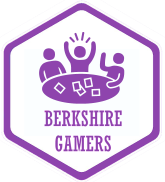3/19/2025 – Berkshire Gamers Session Report #25-11
-
by BerkshireGamers
- 27
• Play: A player chooses one or more adjacent cards in their hand that have all the same value or that have values in consecutive order (whether ascending or descending), then they play this set of cards to the table. They can do this only if the table is empty (as on the first turn) or the set they’re playing is ranked higher than the set currently on the table; a set is higher if it has more cards or has cards of the same value instead of consecutive cards or has a set of the same quantity and type but with higher values. In this latter case when a player overplays another set, the player captures the cards in this previous set and places them face down in front of themselves.
• Scout: A player takes a card from either end of the set currently on the table and places it anywhere they wish in their hand in either orientation. Whoever played this previous set receives a 1 VP token as a reward for playing a set that wasn’t beaten.
Once per round, a player can scout, then immediately play.
When a player has emptied their hand of cards or all but one player have scouted instead of playing, the round ends. Players receive 1 VP for each face-down card, then subtract one point for each card in their hand (except if they were the player scouted repeatedly to end the game). Play as many rounds as the number of players, then whoever has the most points wins.
The idea is to complete same-numbered lines across your board. Scoring is calculated by multiplying the number on the tile with the number of tiles in the completed line. A complete column of three 9s is worth 27, for example…but a lot of players will hope for five 9s to fill the big column down the middle. It is often compared to Bingo because of the familiar pattern of a number being called and then everybody looking at their cards to play it, and then scoring if a line is completed. But that’s as far as the comparison goes. Bingo is sheer luck; Take It Easy is a game of skill.
To combat this, players will need to Buy powerful upgrade cards for their facility in order to become more efficient. These upgrade cards can either be purchased for a lower cost and placed into one’s system (deck) or installed directly to one’s facility to be used every turn for the remainder of the game. After a player has either completed five contracts or installed five upgrades, the game end is triggered and the player with the most Xenon points is the winner.
22 for request night on 3/19/2025 at the UNO Park Community Center Welcome to Christof (friend of Zach) on his first visit 3/19/2025 @ Uno Park Community Center IN: Steve & Sandy, Sean & Wendy, Tim, Armando, Ethan & Amy, Tony & Rachel, Matt, Zach, Chris, Christopher M, Quinn, Nicole, Julie, Rob, Danny, Anna & Peter,…
22 for request night on 3/19/2025 at the UNO Park Community Center Welcome to Christof (friend of Zach) on his first visit 3/19/2025 @ Uno Park Community Center IN: Steve & Sandy, Sean & Wendy, Tim, Armando, Ethan & Amy, Tony & Rachel, Matt, Zach, Chris, Christopher M, Quinn, Nicole, Julie, Rob, Danny, Anna & Peter,…
